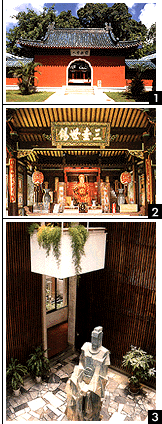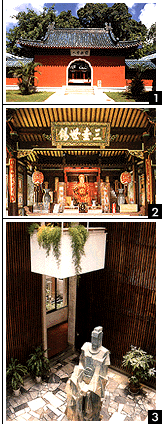Qing2
From Ming to Qing
Since 1589 the
Jurchen had been allies of the Chinese in their war against
the Japanese invaders of
In 1601 Nurhaci created a military administration which was headed by aristocrats form the clans of the alliance. These military units were modeled after Chinese border garrisons that had been established during the Ming. They were called Inner and Outer Banners, the Inner Banners consisted predominantly of Manchus the Outer Banners were kept for auxiliary troops made up from Han Chinese, Mongols etc.
In 1609 the
Manchus formed an alliance with the Eastern Mongols
against their Western relatives. This alliance with the Eastern Mongols, the
enemies of
In 1616 Nurhaci
who was the leader respected by both Manchus and
Mongols now, proclaimed himself Khan and founded the Later Jin dynasty. The
name was chosen in commemoration of the first Jurchen
dynasty with the name Jin dynasty that had ruled in the
A few years
after the proclamation of the Later Jin the Manchus
began attacking the
In 1635 he proclaimed the name Manchu to be used for his people (instead of Jurchen) and the dynastic name Later Jin was changed for Great Qing. With the military and strategic strength the Manchu had gained and with their political unity and administrative organization all prerequisites for a stabile rule had been established.
When the conquest
of
They were entrusted with the internal administration of the palace and with the control of the imperial workshops.
The conquest caused resistance which was quelled with strict laws:
In 1645, when
the Abahai established the capital of the Great Qing in Beijing, all Chinese inhabitants of the northern part
of the city were expelled and had to settle in the southern part, reserved
for the non-Manchu population. All Chinese inhabitants of
Chinese men were ordered to wear Manchu hairstyle: The forehead had to be shaved, the remaining hair was braded in a pigtail which was wound around the head. The same hairstyle, which was popular among peoples in the steppe, had been enforced on Chinese men by the Jurchen during the Jin dynasty.
In the same
year enclaves for exclusively Manchu inhabitants were founded in the
The conquest
of the southern parts of
The rest of
the imperial family and the court fled to
The resistance
in the south lasted some 50 years and was assisted by figures like Zheng
Chenggong (1624-1662), a Ming loyalist who survived
by successfully combining piracy and trade. He was closely associated
with the Southern Ming court and even allowed to use the Imperial family name,
Zhu. This privilege brought him the nickname Guoxingye,
‘Excellency with the royal family’s name’ which was transliterated by the
Dutch and others Westerners as ‘Koxinga’. In order to subdue him and his fellow pirate-loyalists,
the Qing government in 1662 evacuated the entire
coastal regions from
A stern Ming
loyalist, Zheng Chenggong expelled the Dutch
from


Treaty between Koxinga and the Dutch Government
Signed at Zeelandia 1 February 1662
Treaty made and agreed upon; from the one side, by His Highness the LORD
TEIBINGH TSIANTE TEYSIANCON KOXIN, who has besieged Castle Zeelandia on Formosa
since 1st May 1661 up till this 1st day of February 1662; and from the other
side, as representing the Dutch Government, by the Governor of the said Castle,
FREDERIK COYETT, and his Council, consisting of the undernoted eighteen Articles:
Article 1
All hostilities committed on either side to be forgotten.
Article 2
Castle Zeelandia, with its outworks, artillery, remaining war materiel, merchandise, money, and other properties belonging to the Honourable Company, to be surrendered to LORD KOXINGA.
Article 3
Rice, bread, wine, arack, meat, pork, oil, vinegar, ropes, canvas, pitch, tar, anchors, gunpowder, bullets, and linen, with such other articles as may be required by the besieged during their voyage to Batavia, to be taken aboard the Company's ships in keeping with instructions from the before-mentioned Governor and Council.
Article 4
All private movable property inside the Castle or elsewhere belonging to officers of the Dutch Government, shall first be inspected by LORD KOXINGA's delegates, and then placed on board the said ships.
Article 5
In addition to these goods, each of the twenty-eight Councillors shall be permitted to take with them two hundred rijksdaalders, and twenty chosen civilians an aggregate sum of one thousand rijksdaalders.
Article 6
After inspection, the Dutch soldiers may come forth with flying banners, burning fusees, loaded rifles, and beating drums, marching thus for embarkation under command of the Governor.
Article 7
The names of all Chinese debtors or lease-holder in Formosa, with particulars of claims against them, shall be copied out of the company's books, and handed to LORD KOXINGA.
Article 8
All the Government archives may be taken to Batavia.
Article 9
Every servant of the Company, now imprisoned by the Chinese in Formosa, shall be liberated within eight or ten days, and those who are in China, as soon as possible. Servants of the Company who are not imprisoned in Formosa shall be granted a free pass to reach the Company's ships in safety.
Article 10
The said LORD KOXINGA shall now return to the Company the four captured boats, with all their accessories.
Article 11
He shall also provide a sufficient number of vessels to take the Honourable Company's people and goods to their ships.
Article 12
Vegetables, flesh-meat, and whatever else may be necessary to sustain the Company's people during their stay, shall daily be provided by His Highness's subjects at a reasonable price.
Article 13
So long as the Honourable Company's people remain on land before embarkation, no soldier or other subject of LORD KOXINGA shall be permitted to enter the Castle (unless...on service for the Company), to approach the outworks nearer than the gabions, or to proceed further than the palisades erected by order of His Highness.
Article 14
No other than a white flag shall float from the Castle until the Honourable Company's people have marched out.
Article 15
Those who guard the stores shall remain in the Castle two or three days after the other people and goods have been taken on board, and thereafter they shall proceed themselves to the vessels.
Article 16
As soon as this agreement is signed, sealed, and sworn to on both sides, each according to his country's customs, LORD KOXINGA shall deliver to one of the Dutch ships two hostages, viz. the Mandarin or Captain Moor Ongkun and Pimpan Jamoosje of the political Council. On the other side, and as representing the Company, LORD KOXINGA shall receive custody of Mr. Jan Oetgens van Waveren, an official second in rank to the Governor, and Mr. David Harthouwer, also a member of the Formosan Council. Each of these hostages shall remain in a previously fixed place until everything has been carried out in accordance with the terms of this contract.
Article 17
Chinese prisoners at present in the Castle or on the Company's ships shall be exchanged for any of our people who have been seized by the subjects of LORD KOXINGA.
Article 18
All misunderstandings, and every important matter overlooked in this Agreement,
shall immediately be dealt with to the satisfaction of both parties, upon
notice having been given on either side.
LORD CHENG CHEN-KUNG, [L.S.]
FREDERIK COYETT, [L.S.]
Source: Campbell, William. Formosa Under the Dutch (London: Kegan Paul,
Trench, Trubner, 1903), pp. 455-456.

Shrine in honor of Koxinga, Taiwan
As mentioned
before, the initial rul of the Qing had been facilitated
by the service of Chinese officials who had served under the Ming as well.
Some of them became military governors under the Qing
and obtained a rank similar to imperial princes. They were entrusted with
the administration of large parts of southern
Three of these governors became increasingly powerful:
Wu
Sangui who had destroyed the army of the rebel Li Zicheng and then had chased the Ming loyalists to
When the governor
of